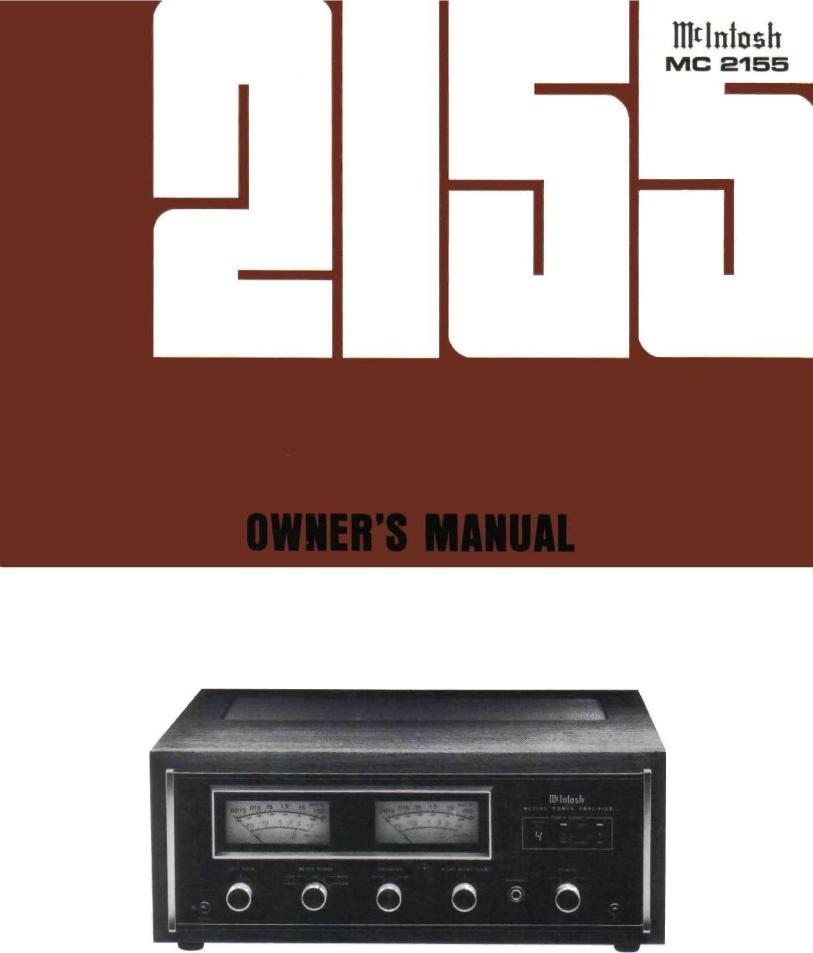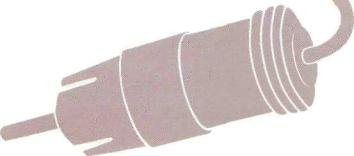McIntosh MC-2155 Owners manual

THE MclNTOSH MC 2155 SOLID STATE STEREO
POWER AMPLIFIER
Reading Time: 31 Minutes |
Price $2.00 |

VARIOUS REGULATORY AGENCIES REQUIRE THAT WE BRING THE FOLLOWING INFORMATION TO YOUR ATTENTION. PLEASE READ IT CAREFULLY.
WARNING: TO PREVENT FIRE OR SHOCK
HAZARD, DO NOT EXPOSE THIS UNIT TO
RAIN OR MOISTURE.
The Mclntosh you have purchased is a Model MC 2155. It has a serial number located on the rear panel of the chassis. Record that serial number here:
Serial Number
The model, serial number and purchase date are important to you for any future service. Record the purchase date here:
Purchase date
Upon application, Mclntosh Laboratory provides a Three-Year Service Contract. Your Mclntosh authorized Service Agency can expedite repairs when you provide the Service Contract with the instrument for repair. To assist, record your Service Contract number here:
Service Contract Number

Your MC 2155 Stereo Power Amplifier will give you many years of pleasant and satisfactory performance. If you have any questions, please contact:
CUSTOMER SERVICE
Mclntosh Laboratory Inc.
2 Chambers Street
Binghamton, New York 13903-9990
Phone: 607-723-3512
Take Advantage of 3 years of Contract Service...
Fill in the Application NOW.
Contents
SERVICE |
1 |
INSTALLATION |
2 |
HOW TO CONNECT |
4 |
FRONT PANEL INFORMATION |
9 |
REAR PANEL INFORMATION |
11 |
PERFORMANCE LIMITS AND RATINGS |
12 |
PERFORMANCE CHARTS |
13 |
TECHNICAL DESCRIPTION |
15 |
BLOCK DIAGRAM |
17 |
MclNTOSH THREE YEAR SERVICE CONTRACT
An application for A THREE YEAR SERVICE CONTRACT is included with this manual.
The terms of the contract are:
1.Mclntosh will provide all parts, materials and labor needed to return the measured performance of the instrument to the original performance limits. The SERVICE CONTRACT does not cover any shipping costs to and from the authorized service agency or the factory.
2.Any Mclntosh authorized service agency will repair Mclntosh instruments at normal service rates. To receive service under the terms of the SERVICE CONTRACT, the SERVICE CONTRACT CERTIFICATE must be presented when the instrument is taken to the service agency.
3.Always have service done by a Mclntosh authorized service agency. If the instrument is modified or damaged as a result of unauthorized repair, the SERVICE CONTRACT will be cancelled. Damage by improper use or mishandling is not covered by the SERVICE CONTRACT.
4.The SERVICE CONTRACT is issued to you as the original purchaser. To protect you from misrepresentation, this
contract cannot be transferred to a second owner.
5.To receive the SERVICE CONTRACT, your purchase must be made from a Mclntosh franchised dealer.
6.Your completely filled in application for the SERVICE CONTRACT must be postmarked within 30 days of the date of purchase of the instrument.
7.To receive the SERVICE CONTRACT, all information on the application must be filled in. The SERVICE CONTRACT will be issued when the completely filled in application is received by Mclntosh Laboratory Incorporated in Binghamton, New York.
8.Units in operation outside the United States and Canada are not covered by the Mclntosh Factory Service Contract, irrespective of the place of purchase. Nor are units acquired outside the U.S.A. and Canada, the purchasers of which should consult with their dealer to ascertain what, if any, service contract or warranty may be available locally.
Copyright 1981 © by Mclntosh Laboratory Inc. |
1 |

The PANLOC system of installing equipment conveniently and securely is a direct result of Mclntosh research. By depressing the two PANLOC buttons on the front panel, the instrument either can be locked firmly in place or it can be unlocked so that the chassis can slide forward, giving you easy access to the top and rear panels.
The trouble-free life of an electronic instrument is greatly extended by providing sufficient ventilation to prevent the build-up of high internal temperatures that cause deterioration. Allow enough clearance so that cool air can enter at the bottom of the cabinet and be vented from the top. With adequate ventila-
tion the instrument can be mounted in any position. The recommended minimum space for installation is 15 inches (38.1 cm)deep, 17 inches (43.2 cm) wide, and 6 inches (15.2 cm) high.
To install the instrument in a Mclntosh cabinet, follow the instructions that are enclosed with the cabinet for any other type of installation, follow these instructions:
1. Open the carton and remove the PANLOC brackets, hardware package and mounting template. Remove the MC 2155 from the plastic bag and place it upside down on the shipping pallet then unscrew the four plastic feet from the bottom of the chassis.
2.Mark the cabinet panel
Place the mounting template in the position on the cabinet pane! where the instrument is to be installed, and tape it in place. The broken lines that represent the outline of the rectangular cutout also repressent the outside dimensions of the chassis. Make sure these lines clear shelves, partitions or any equipment. With the template in place, first mark the six A and B holes and the four small holes that locate the corners of the cutout. Then, join the four corner markings with pencil lines using the edge of the template as a straight edge.
3.Drill Holes
Use a drill with a 3/16 inch bit held perpendicular to the panel and drill the six A and B holes. Then, using a drill bit slightly wider than the tip of your saw blade, drill one hole at each of two diagonally opposite corners. The holes should barely touch the inside edge of the penciled outline. Before taking the next step, make sure that the six A and 8 holes have been drilled.
4. Saw the Panel Cutout
Saw carefully on the inside of the penciled lines. First make the two long cuts and then the two short cuts. After the rectangular opening has been cut out. use a file to square the corners and smooth any irregularities in the cut edges.
2

5 Install the Mounting Strips
In the hardware package you will find two mounting strips and two sets of machine screws. For panels that are less than ½ inch thick, use the ¾ inch screws: for panels that are more than ½ inch thick, use the 1 ¼ inch screws.
Starting at the right-hand side of the panel, insert a screw of proper length into the center hole in the panel.marked B on the template. On the back of the panel, align a mounting strip with the holes in the panel and tighten the screw until the screwhead is pulled slightly into the wood.
Repeat this procedure to attach the mounting strip to the left side of the panel.
6. Attach the PANLOC Brackets
Using two screws of proper length in the A holes on each side, attach the PANLOC brackets to the cabinet panel; the short flange is mounted against the front (face) of the cabinet panel. The screws pass
through the PANLOC bracket flange, the cabinet panel, and then through the mounting strips previously mounted.
7.Install the Instrument
Guide the AC power cord through the panel opening to the back of the cabinet; then, slide the instrument into the opening carefully so that the rails on the bottom of each side of the chassis engage the tracks on the mounting brackets. Continue to slide the instrument into the cabinet until it is stopped by the adjust position latches. Press the latches inward, this permits the instrument to slide into the cabinet until its front panel is flush with the cabinet panel. Depress the PANLOC buttons at the lower left and right corners of the instrument panel to lock the unit firmly in the cabinet. Depressing the PANLOC buttons again will unlock the instrument so that it can slide forward to the adjust position; if you press inward on the adjust position latches then you can remove the instrument from the cabinet.
3

How to Connect
INPUT
STEREO OPERATION
Use shielded cables to connect the signal from the preamplifier or signal source to the power amplifier. To minimize the possibilty of hum the shielded cables should be run parallel to each other or loosely twisted together. Locate the cables away from speaker leads and AC power cords. All connections are made on the back panel of the MC 2155.
For stereo operation, the left output of the preamplifier should be plugged into the Left input jack of the power amplifier. The right output of the preamplifier should be plugged into the Right (Mono) input jack of the power amplifier.
In stereo operation the MODE SWITCH must be in the STEREO position.
MONOPHONIC OR SINGLE CHANNEL OPERATION A shielded cable from the signal source is plugged into the Right (Mono) input jack of the MC 2155 only. The MODE SWITCH on the back panel of the amplifier must be placed in one of the MONO positions. In the MONO positions the output of the right channel input amplifier is fed to both left and right power amplifiers. The Left INPUT is disconnected. Only the signal fed into the Right (MONO) input will
be amplified.
Be certain that the MC 2155 is never operated in the stereo mode with the outputs connected for monophonic operation. Should the MODE SWITCH be left in the STEREO position and the outputs remain strapped for a mono parallel load, one channel will attempt to drive the other which causes high circulating currents and overheating.
OUTPUT
Be certain the loudspeakers connected to the MC 2155 are capable of handling the power output of the amplifier.
Selection of the proper gauge wire to connect the loudspeakers preserves the quality of sound repro-
duction for which the loudspeakers have been designed. If undersize wire is used, resistance is added to the amplifier/loudspeaker combination which adversely affects the performance. Added resistance causes depreciation of damping characteristics, modification of frequency response and reduction in power output.
Use lamp cord or wire with similar insulation to connect the speakers to the amplifier. In all cases, the leads to and from the speaker should be twin conductor or twisted together. When using 8 ohm speakers and for the normally short distances of under 30 feet between the amplifier and speaker, # 18 wire or larger can be used. For distances over 30 feet use larger diameter wire. Select the correct size wire from the chart below. It is recommended that the DC resistance of the speaker leads be less than 5% of the speaker impedance. Resistance of the leads should be computed for the length of wire both to and from the speaker or speakers.
For multiple speaker operation, run separate leads from the amplifier to the speakers.
|
MAXIMUM WIRE LENGTHS |
|
||
Wire |
For 4 Ohm Load |
For 8 Ohm Load |
||
Gauge |
Feet |
Meters |
Feet |
Meters |
18 |
15 |
4.57 |
30 |
9.14 |
16 |
25 |
7.62 |
50 |
15.24 |
14 |
40 |
12.19 |
80 |
24.38 |
12 |
60 |
18.29 |
120 |
36.58 |
10 |
100 |
30.48 |
200 |
60.96 |
Wire lengths above represent the wire resistance equal to 5% of the speaker impedance.
STEREO OPERATION
Check the impedance of the speaker which is usually identified on the speaker itself or in the owner's manual. Connect a lead from the common terminal of the left speaker to the amplifier LEFT OUTPUT terminal strip COMmon screw. Connect
4
